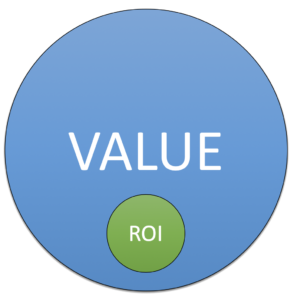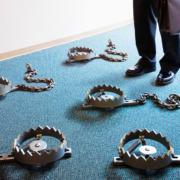3 Surprisingly Simple Things Top Sales Pros Do (That Others Don’t)
American swimmer Michael Phelps is the most decorated Olympic athlete in any sport in history. With 22 medals to his name, if he were a country, he’d be ranked 12th over the three Olympic games from 2004 to 2012. But the price Phelps had to pay in terms of focus and discipline to achieve that result was high. He spent 6 hours training in the water each day, 7 days a week, 365 days a year, for years at a time.
In sales, most reps will tell you they want to be on the top of the dashboard. But the majority simply won’t be because they aren’t committed to doing the things that will set them apart.
And the math is on my side.
Top performers (even farther down the ladder than Phelps) in any discipline represent a small fraction of their respective populations. For example, even when it comes to our physical and emotional well-being, most of us don’t exercise enough, get enough sleep, eat the right foods, or spend enough time offline with our families. The ironic thing is, the problem isn’t lack of knowledge. We all know what it takes to reach the top of our game. But the inertia and status-quo bias with which we travel through life simply prevents us from taking the actions necessary to achieve peak performance. In their 2000 book by the same name, renowned Stanford professors Jeff Pfeffer and Bob Sutton referred to this as the Knowing-Doing Gap.
While achieving peak performance in the modern sales world, like any discipline, requires a sustained regimen of the right behaviors, here are three simple things you can do (that most don’t) to give you an edge.
Note: by providing you with these tips, I’ve assumed that you already have both the drive and desire to be a top performer. Without those prerequisites, these tips will not help you. You have to want it!
1. Read
This is a total no-brainer and one of the easiest things you can do to boost your selling abilities. When it comes to all the primary tenants of modern selling (e.g. messaging, neuroscience, execution, time management, or negotiation, among others) there are literally piles of incredible books packed with golden nuggets of information that can seriously supercharge your game. Unfortunately, studies citing the US Bureau of Labor Statistics have shown that 42% of college grads never read another book after college and that the share of Americans who read on a given day has fallen by more than 30 percent since 2004. In 2004, about 28 percent of Americans age 15 and older read for pleasure on a given day. In 2018 the figure was about 19 percent.
But be careful, reading isn’t just about consuming copious amounts of random blog posts filled with subjective “top 3 lists” (and no, the irony of saying that in this post isn’t lost on me). Part of the magic of reading is making it an ongoing habit as part of your sales education. In fact, it often takes hearing about a topic from several different viewpoints before figuring out how to incorporate it into your own unique approach.
So how should you start, especially if you’re not that into reading? The same way you’d start an exercise regimen. Nice and easy.
Read some blog posts, book summaries, or listen to audiobooks. Once you find a topic you’re keen to dive into, ask your friends or colleagues for some recommendations, or check out some of my favorites.
Leadership Tip 💡: To encourage and make it easy for my team to read, one of the things I used to do was buy copies of my favorite books and leave them at my desk for people to take and keep!
By making the process of recommending, curating, and buying books easy, you can reduce almost all of the friction needed to engage people in this high-value activity.

But regardless of how you go about doing it…DO IT! Find the time even if it’s while riding the subway or at the airport. You’ll be amazed by the impact it will have.
2. Sell Feelings, Not Solutions
Modern neuroscience has proven that humans are emotional creatures first and foremost. What this means in the sales realm is that, from interest to negotiation, our brains trick us into making seemingly logical decisions, that are actually fuelled by emotion and impulse. It’s no surprise then that brand affinity experts talk about how truly great salespeople work on cultivating emotional connections with customers. Great brands avoid selling products. They sell feelings.
Want proof? One of the questions I ask participants in my sales training is, “When a customer makes a decision to purchase a product or service, what percent of the time do they actually buy the BEST solution for their needs?”. The most common answer is typically in the 30-50% range, even when the customer chooses their solution! The reality is, customers buy products and services that meet their functional/technical needs but those needed are overshadowed by their strategic and emotional needs. Retail therapy anyone?
Bonus read: Salespeople: Don’t Confuse Value with ROI

So how can you move from selling solutions to feelings? One of the easiest ways is to ditch your traditional sales pitch (which is typically focused on the details of your product) and lead with polarizing messages and belief statements. Not only will these types of messages resonate more quickly and deeply with your audience but you’ll be able to deliver them with intoxicatingly high conviction. Stirring massive amounts of positive emotions in your customer’s mind and moving them to convert faster!
Bonus video: why you should be selling feelings, not solutions.
3. They Focus on “How” They Sell More Than “What” They Sell!
Have you ever noticed that seemingly normal people behave completely differently when they’re behind the wheel of a car? It’s as though we give ourselves permission to lower our thresholds of patience and human decency the second we have 3000 pounds of steel and glass between us and our fellow commuters. Unfortunately, many traditional sellers similarly believe that the tactics they use to engage (and often bother) prospective buyers are completely acceptable when they’re doing it under the banner of “selling”. They bombard customers with low-value templated emails, disingenuine LinkedIn invites quickly followed by schlocky solution pitches, and generic cold calls for which they haven’t done their homework.
Guess what? In the age where customers have unprecedented access to information, solutions are plentiful, and peer advocacy reigns supreme, such tactics are not only ineffective but will create a horrible customer experience, indelibly tarnishing your personal and product brand!
How you sell matters!
While they are many factors that contribute to how you sell, one of the simplest ways to moderate your approach is to invoke a bit of empathy! Before you engage in any sort of selling or outreach tactic, stop, and ask yourself this question; “If I was the customer, would this tactic work on ME?” If the answer is no, it’s time to get out from behind the wheel and rethink your approach!
Bonus video: how to phrase discovery questions for maximum impact.
When it comes to rising to the top of your game in any field, hard work and commitment to continuous improvement are table stakes. After that, the trick is working smart and being mindful of the simple but high-impact tactics that set you apart from the pack.
We promise never to send you junk or share your email! Just helpful sales insights.














Hands down one of the most simplest, yet effective advice. Keeping these tactics infront of you to remind you how to set yourself apart is the key for anyone. Thank you Cerebral Selling!
Glad you enjoyed the post Taher! Feel free to share with others 🙂